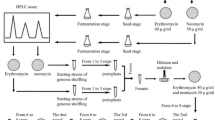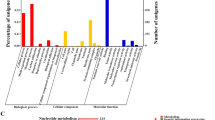Abstract
Spinosad (spinosyns A and D) is a mixture of secondary metabolites produced by Saccharopolyspora spinosa. It is used in agriculture as a potent insect control agent with exceptional safety to non-target organisms. In this study, we applied genome shuffling of S. spinosa to achieve a rapid improvement of spinosad production. Ten strains with subtle improvements in spinosad production were obtained from the populations generated by the mutation with nitrosoguanidine and ultraviolet irradiation, and then they were subjected for recursive protoplast fusion. After four rounds of genome shuffling, a high yielding strain, designated as S. spinosa 4-7, was successfully isolated. Its production reached 547 mg/L, which was increased by 200.55% and 436.27% in comparison with that of the highest parent strain and the original strain, respectively. The subculture experiments indicated that the high producer of S. spinosa 4-7 was stable. Spinosad fermentation experiments by S. spinosa 4-7 were carried out in a 5-L fermentor, and its production of spinosad reached 428 mg/L after 168 h of fermentation.



Similar content being viewed by others
References
Blanc, M. P., Panighini, C., Gadani, F., & Rossi, L. (2004). Pest Management Science, 60(11), 1091–1098. doi:10.1002/ps.930.
Aydin, H., & Oktay Grkan, M. (2006). Turkish Journal of Biology, 30(1), 5–9.
Bylemans, D., & Schoonejans, T. (2000). BCPC Conf.–Pests Dis., 1, 33–40.
Perez, C. M., Marina, C. F., Bond, J. G., Rojas, J. C., Valle, J., & Williams, T. (2007). Journal of Medical Entomology, 44(4), 631–638. doi:10.1603/0022-2585(2007)44[631:SANDIF]2.0.CO;2.
Sparks, T. C., Thompson, G. D., Kirst, H. A., Hertline, M. B., Larson, L. L., Worden, T. V., et al. (1998). Journal of Economic Entomology, 91, 1277–1283.
Sparks, T. C., Thompson, G. D., Kirst, H. A., Hertlein, M. B., Mynderse, J. S., Turner, J. R., et al. (1998). In: F. R. Hall, & J. J. Menn (Eds), Methods in biotechnology, biopesticides: Use and delivery, 5 (pp. 171–188). Totowa, NJ: Humana.
Waldron, C., Madduri, K., Crawford, K., Merlo, D. J., Treadway, P., Broughton, M. C., et al. (2001). Antonie Van Leeuwenhoek, 78(3–4), 385–390.
Waldron, C., Matsushima, P., Rosteck, P. R. J., Broughton, M. C., Turner, J., Madduri, K., et al. (2001). Chemistry & Biology, 8(5), 487–499. doi:10.1016/S1074-5521(01)00029-1.
Jin, Z. H., Wu, J. P., Zhang, Y., Chen, X., Yang, L. Y., & Cen, P. L. (2006). Journal of Zhejiang University SCIENCE A, 8(5), 366–370. doi:10.1631/jzus.2006.AS0366.
Madduri, K., Waldron, C., Matsushima, P., Broughton, M. C., Crawford, K., Merlo, D. J., et al. (2001). Journal of Industrial Microbiology & Biotechnology, 27(6), 399–402. doi:10.1038/sj.jim.7000180.
Parekh, S., Vinci, V. A., & Strobel, R. J. (2000). Applied Microbiology and Biotechnology, 54(3), 287–301. doi:10.1007/s002530000403.
Jin, Z. H., Lei, Y. L., Lin, J. P., & Cen, P. L. (2006). World Journal of Microbiology & Biotechnology, 22(2), 129–134. doi:10.1007/s11274-005-9008-1.
Tao, J. L., Wang, X. D., Shen, Y. L., & Wei, D. Z. (2005). World Journal of Microbiology & Biotechnology, 21(6–7), 969–972. doi:10.1007/s11274-004-7257-z.
Zhang, Y. X., Perry, K., Vinci, V. A., Powell, K., Stemmer, W. P. C., & del Cardayre, S. B. (2002). Nature, 415(6872), 644–646. doi:10.1038/415644a.
Patnaik, R., Louie, S., Gavrilovic, V., Perry, K., Stemmer, W. P. C., Ryan, C. M., & del Cardayre, S. (2002). Nature Biotechnology, 20(7), 707–712. doi:10.1038/nbt0702-707.
Wang, Y., Li, Y., Pei, X., Yu, L., & Feng, Y. (2007). Journal of Biotechnology, 129(3), 510–515. doi:10.1016/j.jbiotec.2007.01.011.
Dai, M. H., & Copley, S. D. (2004). Applied and Environmental Microbiology, 70(4), 2391–2397. doi:10.1128/AEM.70.4.2391-2397.2004.
Hida, H., Yamada, T., & Yamada, Y. (2007). Applied Microbiology and Biotechnology, 73(6), 1387–1393. doi:10.1007/s00253-006-0613-1.
Wang, H., Wang, H., Meng, C., & Guo, Y. H. (2007). Wei Sheng Wu Xue Tong Bao, 34(4), 705–708.
Hopwood, D. A., Bibb, M. J., Chater, K. F., Kieser, T., Bruton, C. J., Kieser, H. M., et al. (1985). Genetic manipulation of streptomyces. A laboratory manual (p. 356). Norwich: John Innes Foundation.
Chen, J. M., & Xu, L. T. (1991). Analysis of antibiotic industry (p. 31, 2nd ed.). Beijing: Chinese Press of Parmaceutical Science.
Zhang, Y., Jin, Z. H., Lin, J. P., & Cen, P. L. (2003). Pesticides, 42(10), 27–28.
Acknowledgments
This work was financially supported by the Natinal Basic Research Program (973) of China (no. 2007CB714305), the National Natural Science Foundation of China (no. 20576122), and the Natural Science Foundation of Zhejiang Province, China (no. Y404291).
Author information
Authors and Affiliations
Corresponding author
Rights and permissions
About this article
Cite this article
Jin, Z.H., Xu, B., Lin, S.Z. et al. Enhanced Production of Spinosad in Saccharopolyspora spinosa by Genome Shuffling. Appl Biochem Biotechnol 159, 655–663 (2009). https://doi.org/10.1007/s12010-008-8500-0
Received:
Accepted:
Published:
Issue Date:
DOI: https://doi.org/10.1007/s12010-008-8500-0




